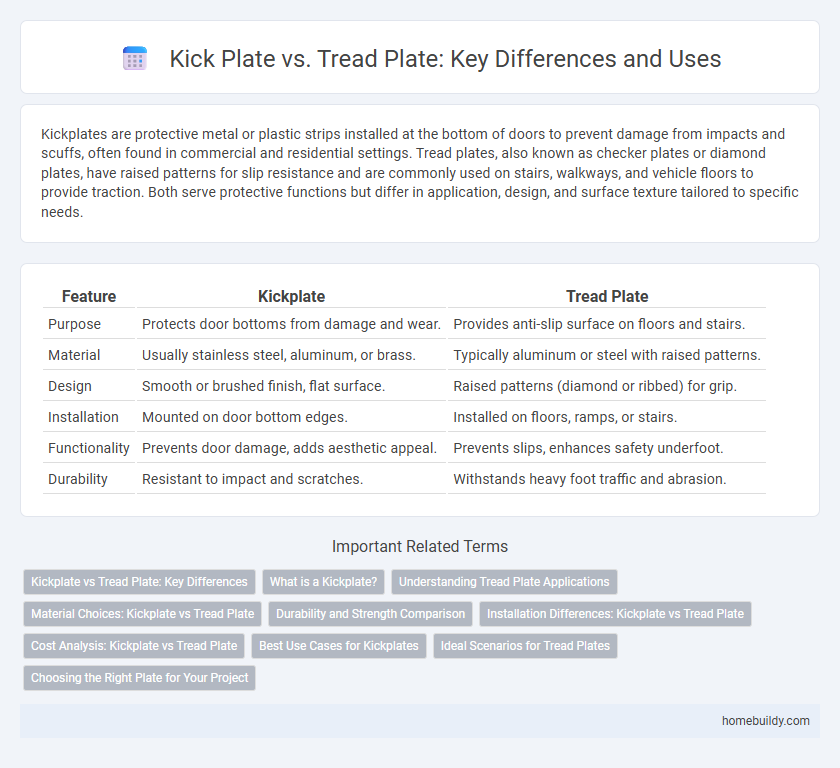Kickplates are protective metal or plastic strips installed at the bottom of doors to prevent damage from impacts and scuffs, often found in commercial and residential settings. Tread plates, also known as checker plates or diamond plates, have raised patterns for slip resistance and are commonly used on stairs, walkways, and vehicle floors to provide traction. Both serve protective functions but differ in application, design, and surface texture tailored to specific needs.
Table of Comparison
| Feature | Kickplate | Tread Plate |
|---|---|---|
| Purpose | Protects door bottoms from damage and wear. | Provides anti-slip surface on floors and stairs. |
| Material | Usually stainless steel, aluminum, or brass. | Typically aluminum or steel with raised patterns. |
| Design | Smooth or brushed finish, flat surface. | Raised patterns (diamond or ribbed) for grip. |
| Installation | Mounted on door bottom edges. | Installed on floors, ramps, or stairs. |
| Functionality | Prevents door damage, adds aesthetic appeal. | Prevents slips, enhances safety underfoot. |
| Durability | Resistant to impact and scratches. | Withstands heavy foot traffic and abrasion. |
Kickplate vs Tread Plate: Key Differences
Kickplates are installed on the lower portion of doors to protect against impact and wear, typically made of smooth or textured metal for durability and aesthetic appeal. Tread plates, often made from aluminum or steel with a raised pattern, are designed primarily for slip resistance on stairs, ramps, and flooring surfaces. While both provide protection, kickplates focus on door surface damage prevention, whereas tread plates enhance safety by preventing falls on walking surfaces.
What is a Kickplate?
A kickplate is a protective metal sheet installed at the base of doors to prevent damage from foot traffic, carts, or equipment, typically made of stainless steel or aluminum for durability and corrosion resistance. Unlike tread plates, which are designed with raised patterns to provide slip resistance on floors and stairs, kickplates primarily serve as impact barriers without textured surfaces. Kickplates enhance longevity and maintain door aesthetics in high-traffic commercial and industrial environments.
Understanding Tread Plate Applications
Tread plate, also known as checker plate or diamond plate, is primarily used for its anti-slip properties on floors, stairs, and walkways, providing enhanced safety in industrial and commercial environments. Kickplates, on the other hand, serve mainly as protective barriers on doors, preventing damage from foot traffic and equipment while also allowing aesthetic customization. Understanding the specific application of tread plates for traction versus kickplates for door protection helps in selecting the appropriate material and design for durability and functionality.
Material Choices: Kickplate vs Tread Plate
Kickplates are typically made from stainless steel, aluminum, or brass, offering a smooth and polished surface ideal for wall protection, while tread plates are commonly fabricated from aluminum or steel with a raised pattern to provide enhanced slip resistance and durability on floors or stairs. Stainless steel kickplates provide corrosion resistance and aesthetic appeal in high-traffic areas, whereas aluminum tread plates deliver lightweight strength and excellent traction due to their textured surface. Choosing between kickplate and tread plate materials depends on the required application, balancing factors such as strength, slip resistance, and visual finish.
Durability and Strength Comparison
Kickplates, typically made from stainless steel or aluminum, offer superior durability due to their resistance to corrosion and impact, making them ideal for protecting doors from frequent contact. Tread plates, often constructed from thicker aluminum with a raised diamond pattern, provide enhanced strength and slip resistance, which is beneficial in high-traffic areas requiring both protection and safety. When comparing durability and strength, tread plates generally withstand heavier impacts and offer better traction, while kickplates excel in maintaining aesthetic appeal and corrosion resistance over time.
Installation Differences: Kickplate vs Tread Plate
Kickplates install flush against door surfaces using screws or adhesive, designed to protect lower door areas from impacts and wear. Tread plates require anchoring to floors or steps, often involving bolts or welding for secure, slip-resistant surfaces under heavy foot traffic. The difference in installation reflects their distinct protective purposes--kickplates for doors and tread plates for flooring.
Cost Analysis: Kickplate vs Tread Plate
Kickplates typically cost less than tread plates due to their thinner gauge and simpler installation requirements, making them a budget-friendly option for protecting doors from damage. Tread plates, often made from thicker aluminum or steel with raised patterns, incur higher material and manufacturing costs but provide enhanced durability and slip resistance in high-traffic areas. When comparing cost analysis, kickplates offer economical protection for doors, whereas tread plates justify their higher price with increased longevity and safety features in flooring applications.
Best Use Cases for Kickplates
Kickplates are ideal for protecting doors against damage in high-traffic areas such as commercial buildings, hospitals, and schools due to their durability and ease of installation. Unlike tread plates, which are designed primarily for flooring and steps to provide slip resistance, kickplates focus on preventing scuffs and dents at the lower part of doors. Their materials, often stainless steel or aluminum, ensure long-lasting protection while maintaining aesthetic appeal, making them the best choice for preserving door integrity and appearance in busy environments.
Ideal Scenarios for Tread Plates
Tread plates are ideal for environments requiring enhanced traction and slip resistance, such as industrial flooring, staircases, and ramps exposed to wet or oily conditions. Their raised patterns provide superior grip, reducing the risk of slips in high-traffic areas or workplaces with heavy machinery. Unlike kickplates, tread plates are designed more for floor and stair safety rather than protecting doors or walls from impact damage.
Choosing the Right Plate for Your Project
Kickplates offer smooth, durable protection ideal for doors, preventing damage from foot traffic and equipment. Tread plates, characterized by raised patterns, provide enhanced slip resistance suitable for flooring and stairs in high-traffic or industrial areas. Selecting the right plate depends on the project requirements: choose kickplates for door safeguarding and aesthetic appeal, while tread plates excel in safety and durability for walking surfaces.
kickplate vs tread plate Infographic

 homebuildy.com
homebuildy.com